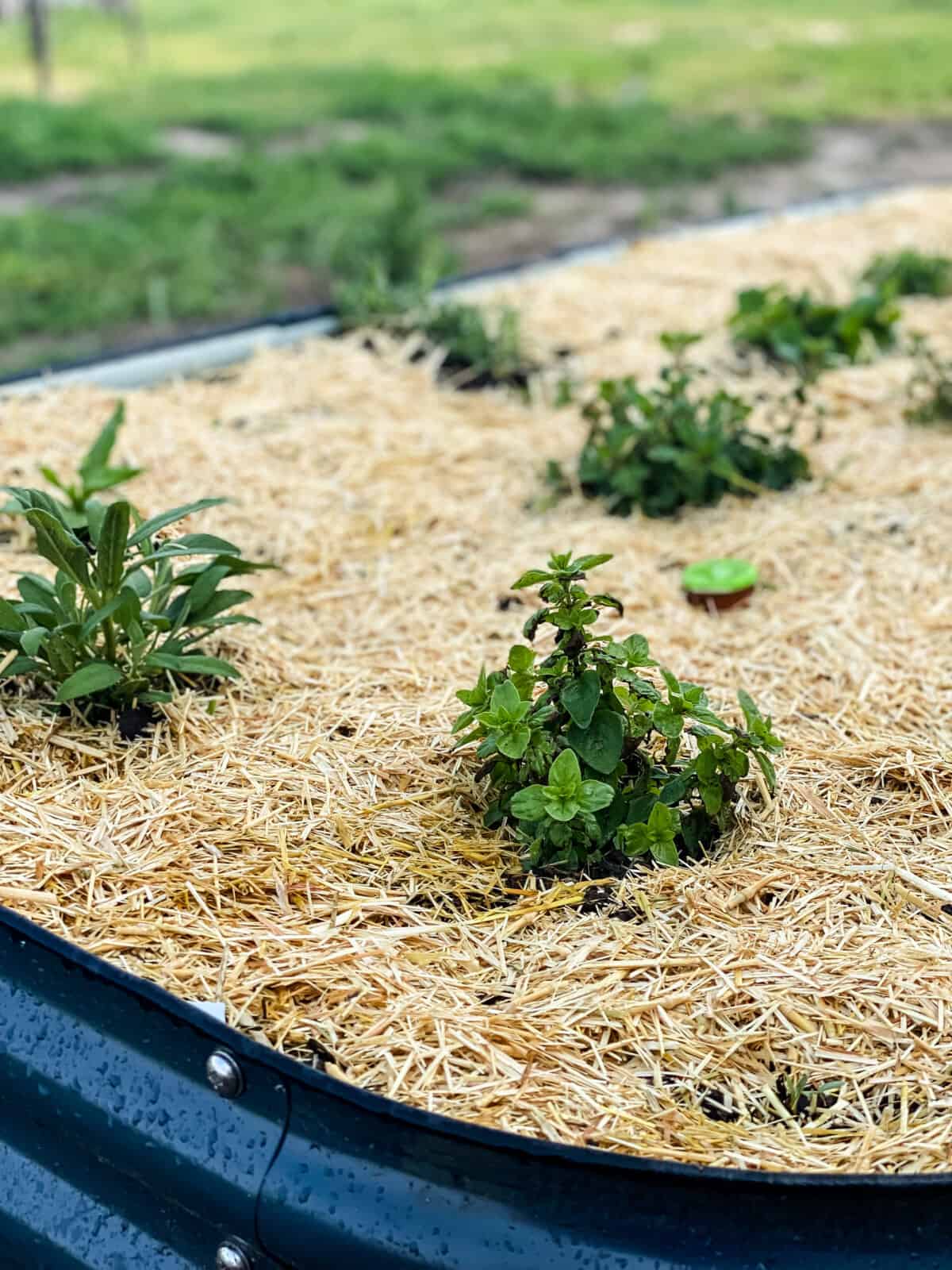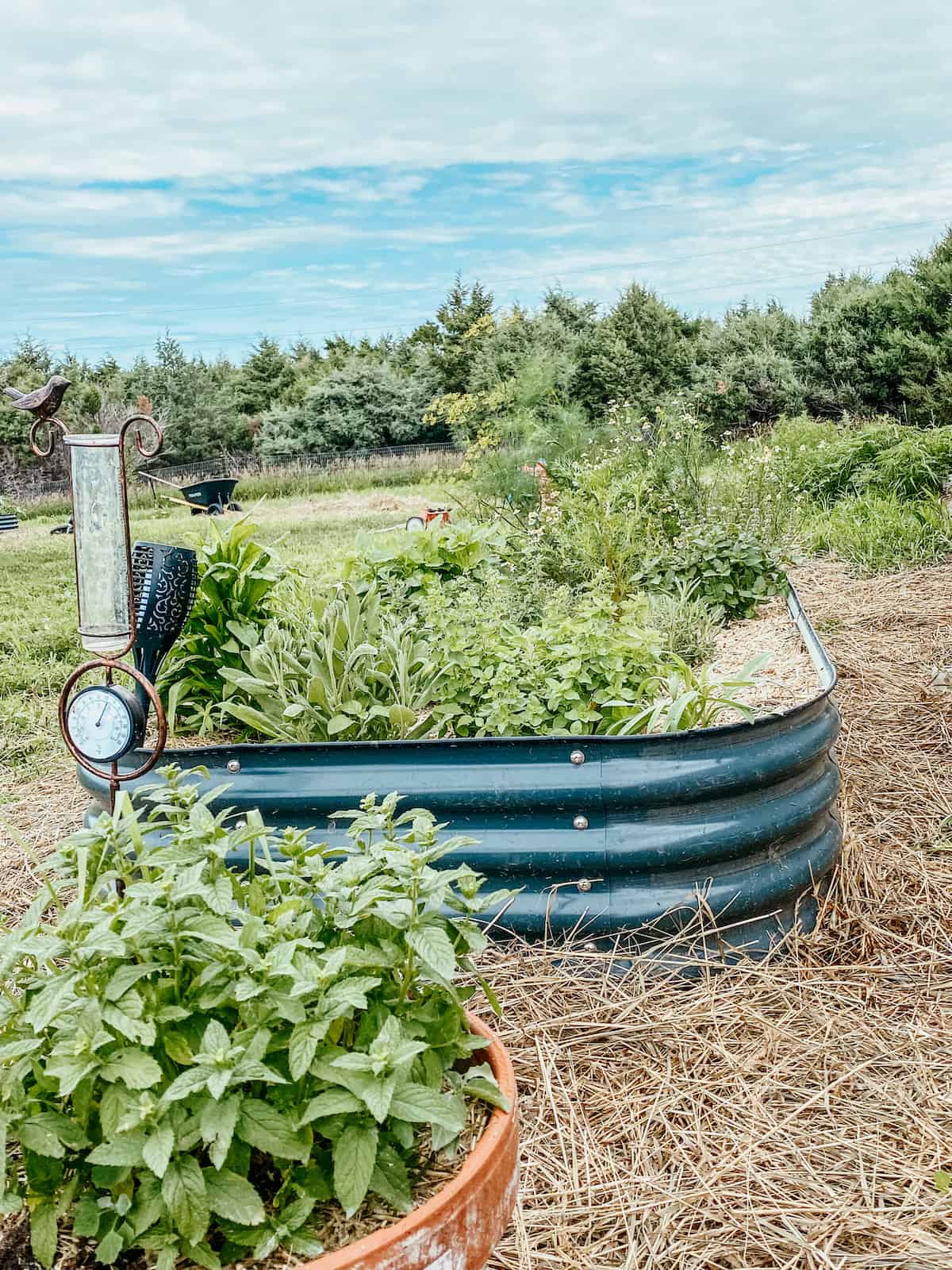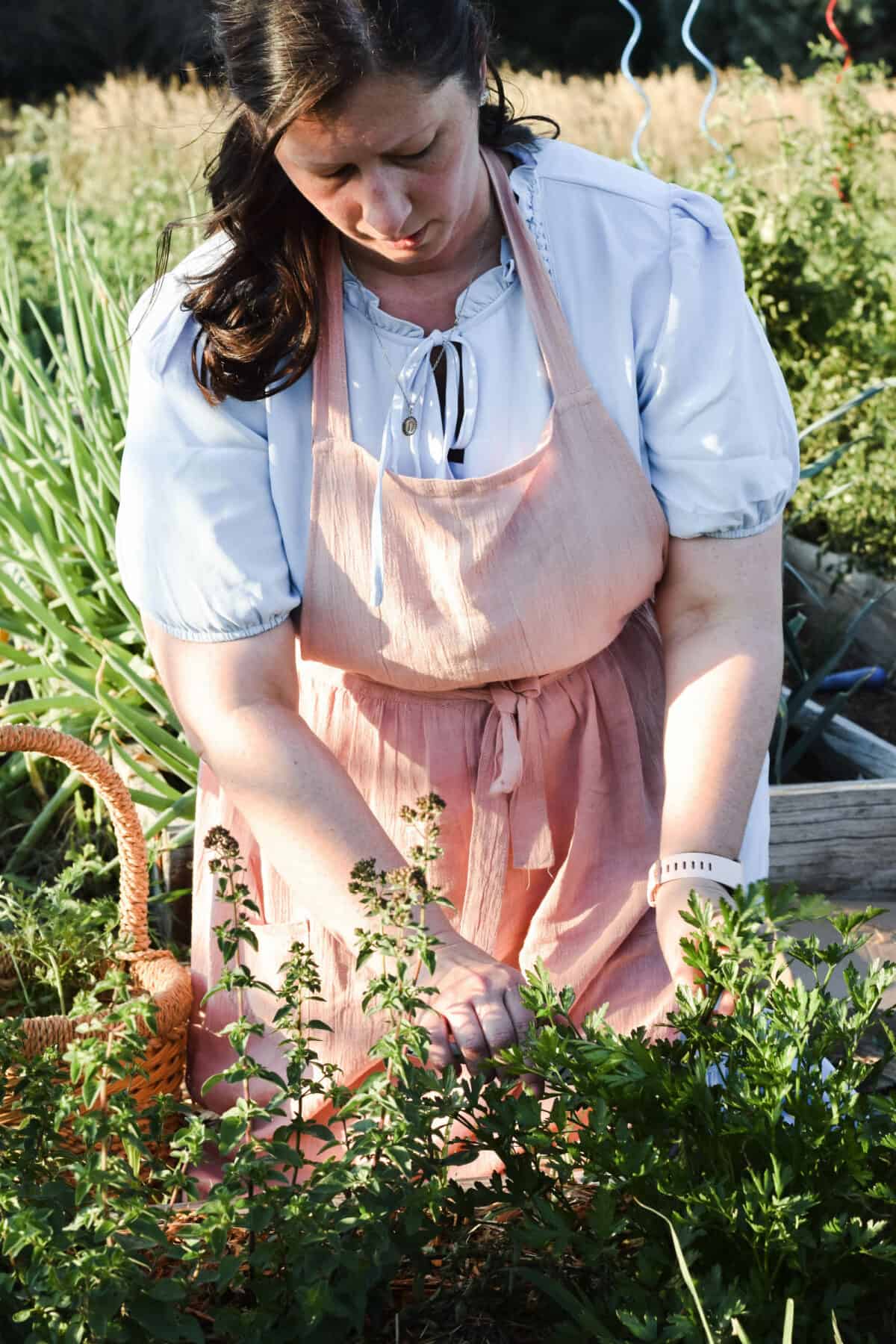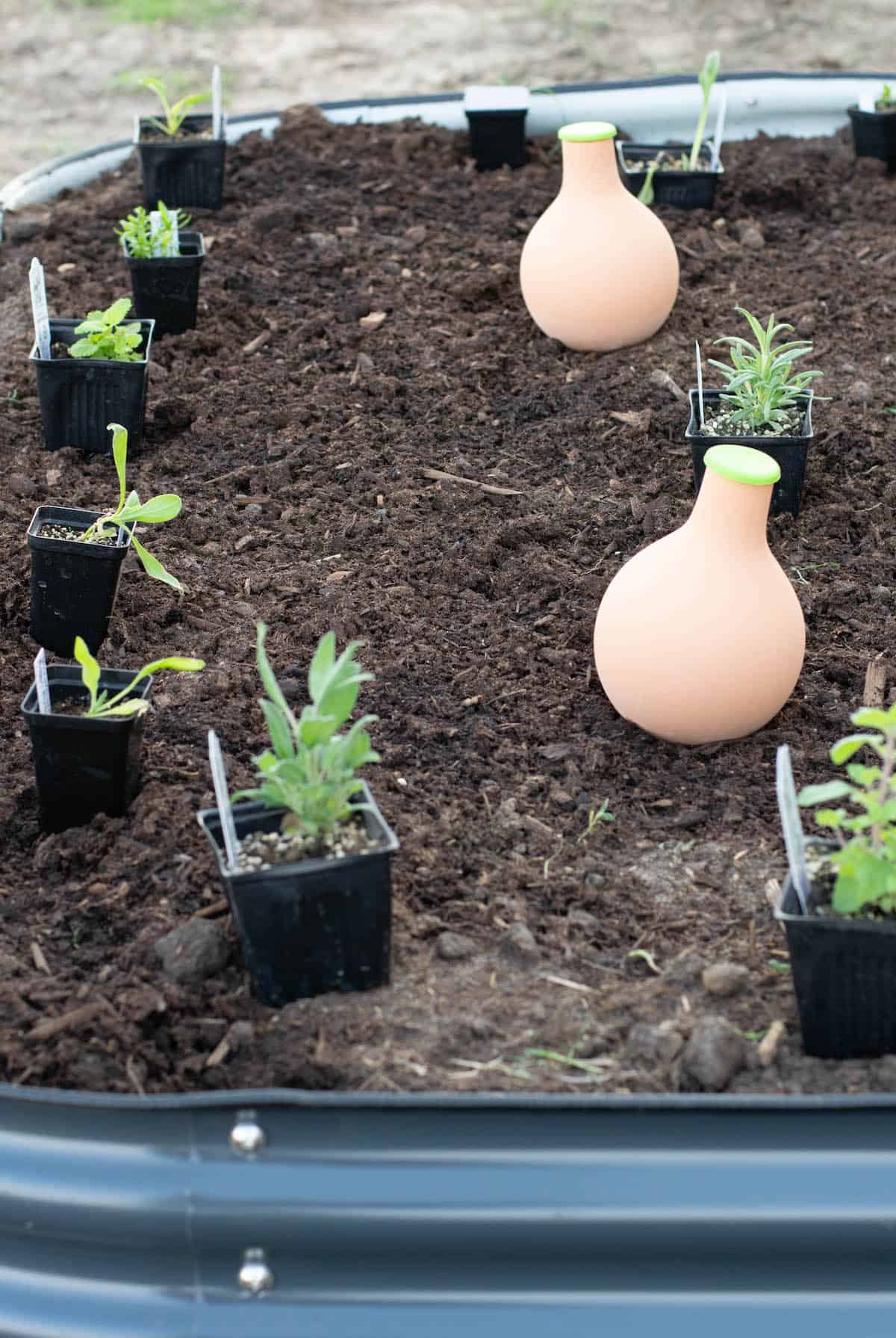Herbs are an easy and inexpensive way to add flavor and freshness to all sorts of dishes. They’re also great accents to an attractive raised garden bed. Today I am sharing how we built a new raised bed herb garden.
I hope that this post will inspire you to build your own herb garden bed. One that is full of delicious herbs for teas, fresh salads, soups, sauces, and your most favorite recipes!
As a firm believer in companion planting, I already have herbs and florals scattered throughout the kitchen garden. But I also wanted the convenience of running out the kitchen door for fresh herbs as needed when preparing a meal.
Having a herb garden can be an incredibly rewarding experience. Fresh herbs add amazing flavor to foods, provide natural remedies, and even decorate your outdoor space While you can grow herbs in individual containers, creating a dedicated herb garden bed allows you to plant a variety of herbs together
With a well-planned design, raised beds offer an efficient way to cultivate herbs. The confined space intensifies care while the elevated structure reduces bending. But how exactly do you optimize a raised bed for herbs? Follow this complete guide to designing the perfect herb garden raised bed layout.
Selecting the Right Location
When choosing a spot for your raised herb bed, aim for an area receiving at least 6-8 hours of sunlight daily. Herbs thrive with ample light. Situate the bed near your kitchen if possible for easy harvest while cooking. Just avoid planting under trees or shadows that could limit sunlight.
If you live in a windy area, consider placing the raised bed along a sheltered wall or fence. This shields herbs from harsh winds which could damage or dry out plants.
Constructing the Raised Bed
Build your raised bed at least 12-18 inches tall to provide sufficient room for quality soil. The bed itself should measure a minimum of 4 feet wide by 8 feet long to fit a variety of herbs.
Use rot-resistant cedar, redwood or plastic lumber for the sides of the raised bed. Or opt for a permanent structure made of bricks, concrete blocks, or stone. Just be sure the bed offers adequate drainage.
Add a weed barrier at the bottom made of landscape fabric or hardware cloth to prevent weeds. Then fill with a high quality potting mix blended with compost for nutrition.
Dividing into Sections
Divide your raised bed into organized sections based on sunlight and water requirements. This allows you to group complementary herbs together.
-
Full sun section for Mediterranean herbs like rosemary, thyme and oregano
-
Partial shade section for mint, chervil, parsley and other herbs preferring some shade
-
Moist soil section for thirsty herbs like basil, cilantro and dill
-
Dry soil section for lavender, sage and herbs that thrive in drier conditions
Use dividing planks, bricks or stones to create the organized sections within the overall raised bed.
Mapping Out Planting Layouts
Carefully plan where to place each herb variety for optimal growth. Here are some effective raised bed layouts to try:
-
Rectangular – Plant taller herbs like fennel in center. Shorter herbs along edges for easy access.
-
Circular – Tallest herbs in middle, surrounded by medium then short height herbs.
-
Square Foot – Divide into 1’x1’ squares for intensive herb planting.
-
Hexagonal – Create honeycomb pattern with hexagons for neat, organized spaces.
-
Potager Style – Mix herbs, flowers and ornamentals together inspired by French potager gardens.
Choosing the Right Herbs
When selecting herbs, opt for a diverse blend of annuals and perennials.
Popular Annual Herbs:
- Basil
- Cilantro
- Dill
- Parsley
Great Perennial Herbs:
- Lavender
- Lemon Balm
- Mint
- Oregano
- Rosemary
- Sage
- Thyme
Be sure to check the growing conditions of each herb to ensure your layout and soil suits their needs.
Sample Raised Bed Herb Garden Plans
Culinary Herb Garden – Grow cooking herbs like basil, parsley, cilantro and dill together.
Tea Herb Garden – Plant mint, lemon balm, chamomile and lavender for fresh herbal teas.
Mediterranean Herb Garden – Fill the sunny dry section with rosemary, oregano, thyme and sage.
Ornamental Herb Garden – Mix beautiful ornamentals like lavender and colorful sages with flowers.
Caring for Your Raised Bed
-
Water each section based on needs. Avoid overwatering.
-
Weed weekly and mulch beds.
-
Fertilize with compost or organic plant food.
-
Prune herbs regularly to encourage new growth.
-
Check for pests like aphids and treat organically.
Start Growing Herbs in a Raised Bed
With the right location, construction, layout and care you can create a thriving raised bed herb garden. Start small then expand as you gain experience. The fresh flavors and scents will make all the effort worthwhile!

What herbs to grow in raised beds
Since everyone has so many individual culinary tastes, I will say that this is dependent on what you love to cook with!
I’m a pretty big believer in growing what you and your family enjoys to eat.
We have things like garlic chives, medicinal herbs, lavender, basil, and some other annual herbs scattered in the main garden beds as part of our companion planting plan.
Companion planting has many benefits – some of which are for drawing in pollinators like bees & butterflies with a variety of florals. And another is to deter common pests with herbs and other plants.
Before planing out the spring garden, we started many of the herb plants from seed. Most of those were planted in the original herb garden space and scattered among our main garden spaces.
I also purchased some really good quality herb plant starts from Azure Standard. This is a great option if you don’t have access to organic plant starts locally. I usually order some of my annual herbs from Azure when I don’t start from seed. They always arrive in excellent condition!
In this new culinary herb bed I added my most commonly used herbs in recipes. Check out some favorite ways to use fresh herbs with these recipes on one of my other websites:

I chose to add mostly perennial herbs, with a few annuals, some medicinal herbs that I had extra, and even some flowers for ascetic.
Here’s what we added this year:
- rosemary
- oregano (2 plants – I am Italian! )
- parsley
- sage
- thyme
- cilantro (from seed – they have just sprouted. And I’m going to attempt succession sowing them this year)
- French tarragon
- lemon balm (so good in tea!)
- tulsi aka holy basil (also great in tea)
- dill
I also had a few extra medicinal herbs that we added to this bed:
I even planted a few flowers like cosmos, strawflower, and zinnias for the pollinators and ascetic.
Mint is grown in it’s own planter because it has a tendency to become invasive. This year I’m growing separate pots of both spearmint and peppermint. We love to use the leaves of the spearmint in teas. And peppermint makes a great compliment to many meat dishes.

And this next photo is of the herb garden bed after about a month of growth. I love how much it has filled in the space in such a short amount of time!

How to create a raised bed herb garden
There’s so many wonderful benefits of gardening in raised beds. My favorite benefits are the accessibility and ease on my aging back.
They’re also such a beautiful addition to the garden space and are so much more easier to maintain. And harvesting & pulling weeds from a raised bed garden is so much easier than our previous in ground gardens.

We started this new herb bed build with our favorite metal raised garden beds from Olle Gardens. I chose the 12-in-1 kit for this herb bed.
If you are using a landscape fabric or something below the raised bed to help with weed prevention, it is ideal that you provide good drainage to prevent excess water from building up. Simply cut small drainage holes throughout the fabric before filling the beds.
Next we filled the raised bed with layers of organic matter. Such as old logs, sticks, old hay, quality organic topsoil, compost (I really like to use mushroom compost in the garden), and then topped with garden straw as a mulch after planting.
And before planting the herb bed, I suggest laying everything out to get an idea of placement. You want to check how large the plants grow and provide for adequate spacing.
In addition, I added two small Growoya watering pots to the center of the bed to help in limiting hand watering.

The Perfect Match: Herb Garden Guide – A Guide to Companion Planting Your Herb Garden
FAQ
How do you arrange herbs in a raised bed?
As for general guidance on herbs, you have a little wiggle room, but here are the basics: 6″ apart: Parsley, Chervil, Oregano. 12″ apart: Basil, Dill, Chives, Rosemary, Sage, Thyme. 18″ apart: Coriander, Lavender, Mint.
Which herbs to plant together in a raised bed?
For raised bed herb gardens, consider planting basil with oregano, rosemary, and thyme together as they share similar needs for sunlight and moisture. Alternatively, dill, cilantro, and parsley thrive when planted together due to their shared preferences for sunlight and water.
How deep should a raised bed be for herbs?
How deep does a raised bed need to be for herbs? Many of the herbs you might want to grow in your garden have shallow root systems that only need about 6 inches of raised bed or container depth.
What is the best layout for an herb garden?
The simplest design would be four beds, each a square yard (or square metre) in size, around a sundial or small round bed containing one tall herb – a Rosemary bush or Bay tree as a permanent feature, or Fennel, which would grow up every year and offer sculptural stems in winter.
What is a raised bed herb garden?
A raised bed herb garden allows you to grow a variety of fresh herbs right at your fingertips. With the right design and layout, you can maximize your space while creating an inviting and functional herb garden. In this article, we’ll explore how to design the ideal raised bed herb garden.
How do you design a raised bed herb garden?
In this article, we’ll explore how to design the ideal raised bed herb garden. When selecting a spot for your raised bed, choose an area that receives at least 6-8 hours of direct sunlight daily. Herbs thrive in sunny locations. Avoid planting under trees or shadows that will limit the light.
What is a good design for a raised herb garden?
You’ll find plenty of options for herb garden designs: raised beds for pest protection, containers for small spaces, vertical setups that save room, pollinator-friendly layouts, and portable arrangements that you can move around. What is the best design for a raised herb garden?
Can you grow herbs in a raised bed?
You’ll enjoy a much wider range of flavours, too. You can grow herbs in a separate area of your garden, but if you don’t have much room, you can make one in a raised bed, a big pot, or even a window box. A raised bed herb garden allows you to grow a variety of fresh herbs right at your fingertips.
How tall should a herb garden be?
Raised beds 8 to 12 inches in height are best for small herbs. For herbs that grow taller and prefer drier soils, we suggest going for taller raised beds and using a porous growing medium instead of ordinary garden soil. What is the best layout for an herb garden?
How do you decorate a raised bed?
Raised beds work great for this style. I arrange them in a symmetrical pattern around a central feature like a fountain or herb spiral. I plant vegetables, herbs, and flowers together in each bed. This creates a colorful, productive space that’s also pretty to look at. 10. Raised Bed with Pathways I love raised beds with pathways between them.
